Strawberries
Verticillium wilt and Compost Amendments
Verticillium dahliae is the cause of Verticillium wilt, a disease that affects strawberries and many other plant species, including annual vegetables, fruit trees, nut trees and fiber crops, as well as weeds and native plants in California. Once a susceptible plant is infected, V. dahliae can produce large numbers of survival structures (called microsclerotia) (Vallad and Subbarao, 2008), which can survive in the soil for more than 14 years (Wilhelm, 1955). In addition, V. dahliae can colonize the roots of many crops that are not susceptible to disease and may show no symptoms (Lloyd and Gordon, 2011). This provides another means by which the fungus can produce survival structures. Verticillium dahliae is easily spread between fields with soil on farming equipment. It can also be introduced with seed (Wu and Subbarao, 2014) or infected transplants. Owing to the ease of dispersal, a wide host range and production of long-lived survival structures, V. dahliae is resident in agricultural soils throughout the state. Whether or not Verticillium wilt occurs in a particular situation is determined by the susceptibility of the crop variety being grown and the abundance of inoculum in soil. Consequently, the absence of disease does not mean the pathogen is not present. In fact, it is likely that V. dahliae occurs at some level in most fields in coastal California. Good management practices aim to keep the inoculum level below a damaging threshold (Gordon and Subbarao, 2007).
Many growers use compost amendments to improve the physical and chemical properties of soil. Compost can also enhance the activity of microorganisms that are inhibitory to plant pathogenic fungi (Mazzola, 2004). However, compost made from crop residue may include plants that were infected with V. dahliae, and because microsclerotia can survive in animal guts (Markakis, 2014), manure may be contaminated as well. Proper composting is required to ensure that no viable microsclerotia remain in the final product. The California Composting Council and CalRecycle have established regulations that require materials reach 55 °C (131°F) or higher for 15 days or longer with a minimum of five turnings of the windrow during this time (Cal Recycle, Title 14, Chapter 3.1), which should be sufficient to kill V. dahliae microsclerotia in manure or crop residue (Baker, 1957). All state permitted composting facilities are visited monthly by the local enforcement authority (LEA) to ensure compliance with these regulations. Consequently, if your supplier is operating under a state permit, the compost you purchase is unlikely to be a source of inoculum of V. dahliae, and it would not be advisable to forego the benefits of compost amendments out of concern that this will increase the risk of damage from Verticillium wilt.
REFERENCES
Cal Recycle. Title 14, Chapter 3.1. Composting Operations Regulatory Requirements, Article 5. Composting Operation and Facility Siting and Design Standards, Section 17868. 3. Pathogen Reduction. http://www.calrecycle.ca.gov/Laws/Regulations/title14/ch31a5.htm
Baker, KF and Roistacher, CN. 1957. Heat treatment of soil. In K.F. Baker [ed]. The U.C. system for producing healthy container-grown plants. Calif. Agr. Exp. Sta. Manual 23:123-137.
Gordon, TR and Subbarao, KV. 2007. Production Guidelines: Verticillium wilt of Strawberry. California Strawberry Commission, Issue 1: 1-4.
Lloyd, M and Gordon, TR. 2011. Evaluation of ten leguminous cover crops as cryptic hosts for Verticillium dahliae. Phytopathology 101: S109-S109.
Markakis, EA. et al. 2014. Survival, persistence and infection efficiency of Verticillium dahliae passed through the digestive system of sheep.Plant Disease, (ja).
Mazzola, M. 2004. Assessment and management of soil microbial community structure for disease suppression. Annual Review of Phytopathology 42: 35-59.
Vallad, GE and Subbarao, KV. 2008. Colonization of resistant and susceptible lettuce cultivars by a green fluorescent protein-tagged isolate of Verticillium dahliae. Phytopathology 98:871-885.
Wilhelm, S. 1955. Longevity of the Verticillium wilt fungus in the laboratory and field. Phytopathology 45:180-181.
Wu, B and Subbarao, KV. 2014. A model for multi-seasonal spread of Verticillium wilt of lettuce. Phytopathology 104:908-917.
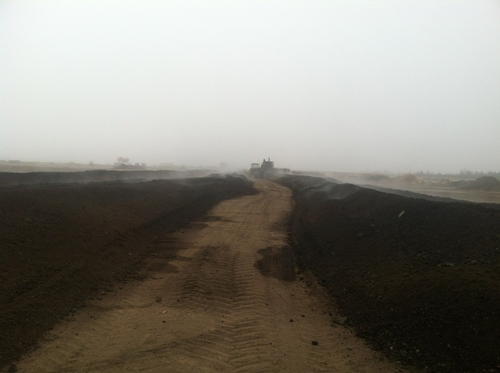
Windrows of compost. Photo courtesy Margaret Lloyd, UC Davis
Patchiness of Micronutrients in the Field
Nice note here from the International Plant Nutrition Institute on the patchiness of micronutrients in the field:
It's a pretty short article, but there is a very important point being made. Micronutrient deficiencies don't happen over the whole field and occur as a result of the spatial variability in soil characteristics that end up affecting micronutrient availability to the plant. These soil characteristics are things like pH, texture, organic matter, cation exchange capacity, EC and soil drainage.
The kicker for the grower or field practitioner is assessing the true extent of the micronutrient deficiency in the field since it is so patchy. Hard to make calls on something like this.
Extension in the information age
Interesting article this weekend on the UC ANR homepage concerning extension in the information age.
http://ucanr.edu/?blogpost=15394&blogasset=52096
More on this at a later date, but this article covers neatly some of the thoughts I've had on how we at UCCE are using the web to extend and enhance our ability to serve.
It's a little wonkish, so I'll summarize the key takeaways here:
- Knowledge and information is produced and distributed by a network of people, not an individual. I can't any imagine any scientist being very successful in our industry working on his or her own these days, it's a given to bring representatives from all sorts of disciplines into a project, and then growers participate to keep things realistic and practical.
- Interesting note that partnerships can form across agricultural sectors, I would have to agree. Information flows pretty readily between our strawberry and caneberry industries, and I like to think that we have a decent connection with the lettuce and cool season vegetable industry.
- Last but not least, online information technologies can be innovative ways to connect and learn, but will never be a substitute for personal and in-person connections. In my opinion, an Advisor will not thrive simply by writing blogs and posting on social media. My experience is that these technologies enhance and enrich the work I am doing, but of course will never ever substitute for time in the field with the people we are here to serve.
Good article, it looks like the research is confirming what we are realizing in the field.
A Few Observations on Vinegar Flies in Strawberries
As any grower knows, vinegar flies, Drosophila spp., have been a major deal in strawberries the last few years. It seems the slightest delay in picking (especially in the fall) is met with an onslaught of vinegar flies followed by a huge loss of fruit.
I have the good fortune to be funded this year by the North American Strawberry Growers Association (NASGA) on a study looking at predaceous nematodes as a way of controlling vinegar flies. More on that at a later date, but having my research assistant Monise Sheehan and I spend some time looking closely at vinegar flies in strawberry brings up some observations that I would like to share here.
First of all, regular vinegar flies, as opposed to the spotted wing drosophila, Drosophila suzukii, do not oviposit in fruit, rather they oviposit on the surface. I am going to underline that this doesn't at all mean they won't damage the fruit, since it is only 24 hours each one spends in the egg stage before becoming an active larva fully capable of penetrating into the fruit.
It is interesting to see where the egg laying is taking place. It's uncommon to see eggs just deposited on a healthy fruit (Photo 2); it is rather in wounds (Photo 3) and cracks (Photo 4), bruises and any other kind of damage which softens and compromises the integrity of the fruit where the bulk of the eggs are found.
I think the take home message for strawberry growers and supporting professionals is to know how very fast the life cycle of vinegar flies goes and the big role that damage, be it wounds, cracking, bruising or general softness has in promoting their development.
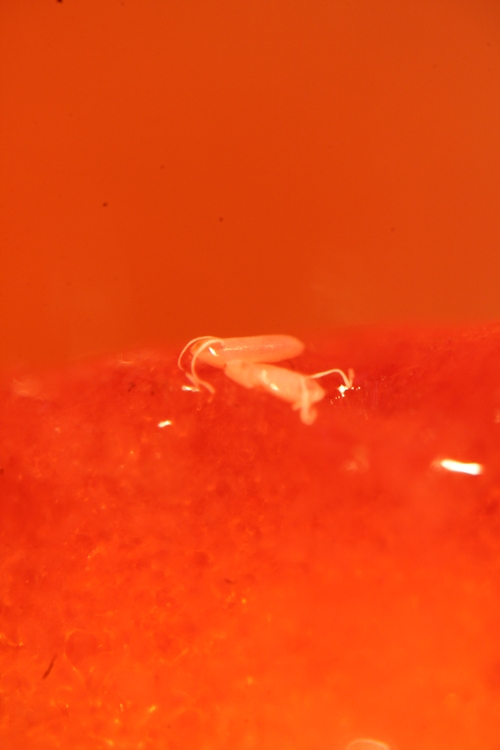
Photo 1: Vinegar fly eggs under the microscope. Long fibers are respiratory tubes.
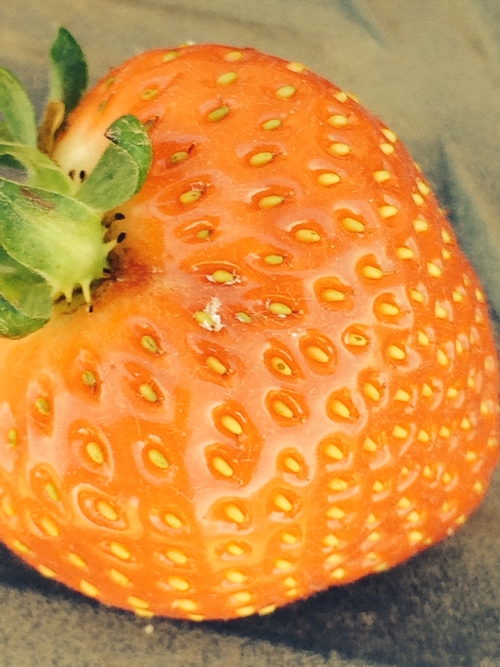
Photo 2: Mass of vinegar fly eggs on an ostensibly healthy fruit. The immaturity of this fruit is notable.
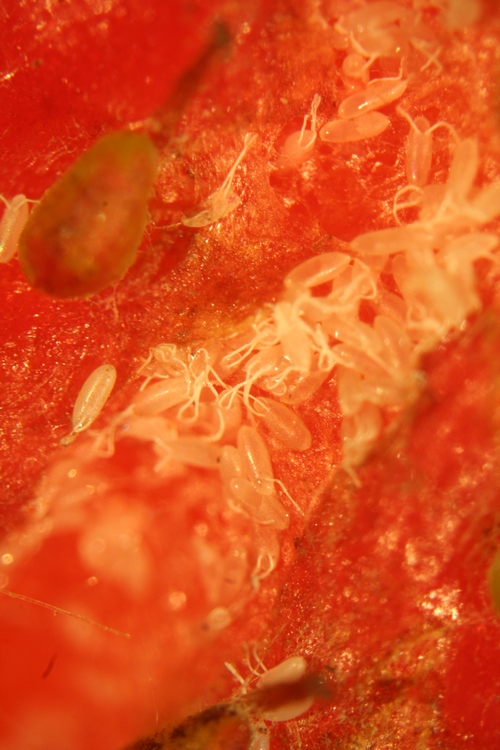
Photo 3: Mass of vinegar fly eggs in fruit wound, rendering it totally unmarketable.
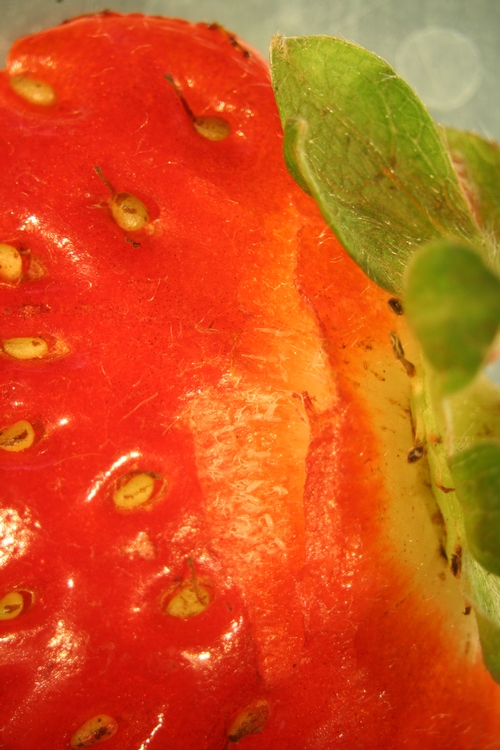
Photo 4: Vinegar fly eggs nicely lined up in crack under calyx. This fruit is lost.
Bagrada bug links
Bagrada bug is not necessarily a pest of strawberry or caneberry, but I get a lot of questions about it. It's good to be familiar with the basics at least.
http://www.ipm.ucdavis.edu/PMG/PESTNOTES/pn74166.html
And some blog posts by colleagues Joseph and Dara
//ucanr.edu/blogs/blogcore/postdetail.cfm?postnum=14915
//ucanr.edu/blogs/blogcore/postdetail.cfm?postnum=11632
http://westernfarmpress.com/vegetables/bagrada-bug-marching-north-california-crops
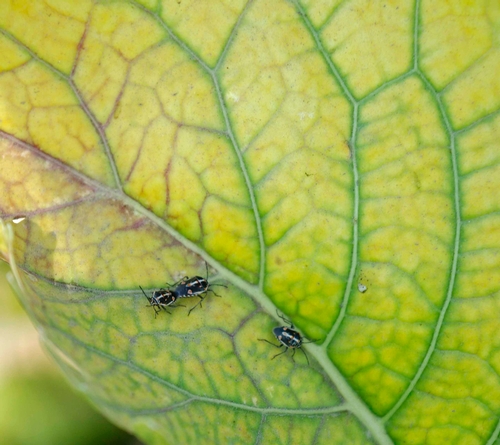
Bagrada bugs on horseradish

